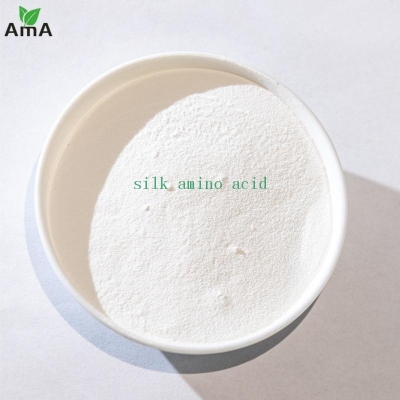Advances in the application of amino acid additives in pig feed
-
Last Update: 2020-06-30
-
Source: Internet
-
Author: User
Search more information of high quality chemicals, good prices and reliable suppliers, visit
www.echemi.com
the application of amino acid additives in pig feed research progressbFCLu Youare 1 Liu Shumin 1 Liu Ping 2 Zhang Ying 3 Wang Guangguang 4bFC1The Animal Husbandry Technology Promotion Center of Minnan City, Shaanxi Province (Yannan 714100); 3Chengcheng County Livestock Bureau, Minnan City; 4Huayin Livestock Bureau of Yannan CitybFCin the figure classification number: S816.7, S828.5 document identification code: C article number: 1002-2996 (2014) 03-0027-03bFCsummary: China's large population, protein feed raw materials shortage, human and animal food phenomenon restricting the development of China's pig industryThe rapid development of feed amino acid industry has brought new hope to feed industry and aquaculture industry in ChinaHowever, in the application of fed amino acids, there are problems such as insufficient application range, unreasonable addition amount and unreasonable matchingThe author summarizes the relevant research results at home and abroad, and expounds the progress of the application of feed amino acids in pig feed from the following four aspects: (1) the history and current situation of the development of amino acid industry;bFC
Keywords: amino acids, ideal amino acid model, net energy system, electrolyte balancebFCwith the rapid development of China's animal husbandry, the phenomenon of human and animal food competition and protein raw material shortage has been an indisputable factBecause the utilization rate of nitrogen in japanese grain is low, nitrogen that is not digested and absorbed is excreted into the dung, and nitrogen that is not produced and utilized after digestion and absorption is mainly excreted in the form of urine nitrogen, which is not only a waste of protein raw materials, but also increases the pressure on the ecological environmentS70% of the nitrogen taken by pigs is excreted into the environment through fecal urine, of which about 20% is excreted through feces and 50% by urineTherefore, the content and digestion of nitrogen in the feed determine the yield of dung nitrogen, the amount of nitrogen absorbed and its utilization rate determines the content of urine nitrogenBy adding synthetic amino acids to pig's diet, reducing the input of feed crude protein has become an important technology to reduce the cost of breeding and reduce the environmental pollution caused by excessive nitrogen dischargebFC
1· The history and current situation of the development of amino acids for feedingbFCamino acids are generally known as organic compounds containing amino and argon-based, of which there are 20 kinds of protein amino acids and more than 450 kinds of non-protein amino acidsAmino acids are the basic unit of protein and an important part of biological organismsAmino acids as human nutrition additives, flavorings, feed nutrition additives, medicine and many other aspects in the food industry, agriculture, animal husbandry and human health care and many other aspects have a wide range of applications, of which feed additives accounted for 30% to 40%The amino acid industry has grown rapidly for more than 140 years, starting with the use of sulphate hydrolysiswheat wheat gluten in 1866 to obtain glutamateIn 2011, the global amino acid industry alone reached 2.89 million ts, with a market value of more than $9.5 billion Among them, China's production of feed amino acids reached 910,000 ts, the top four are lysine, methionine, sucrose and tryptophan bFC
2· The effect of adding amino acids to feed bFC has been widely used to add amino acids to feed Generally in grain and soybean meal-based plant feed lysine, methionine and other content is low, can not meet the needs of animals, adding amino acids can greatly save protein consumption, reduce feeding costs, improve animal productivity bFC
Adding amino acids can improve the quality of pork Adding lysine to pig feed can improve meat quality and lean meat Experiments show that adding lysine to animal feed can improve the efficiency of synthetic proteins in animals, reduce the fat content of animals relatively, increase the proportion of lean meat, and improve the meat quality bFC
Adding amino acids can improve animal digestion and reduce environmental pollution In intensive feeding piglets, the crude protein content is high, prone to diarrhea and other digestive diseases This not only causes waste of feed, but also affects animal growth By reducing the protein level of animal diet and adding methionine, lysinine and glutamate, we can not only effectively improve the digestive function of animals, reduce disease, enhance the resistance of animals, but also reduce the discharge of fecal nitrogen and urine nitrogen, effectively improve the small environment of pig houses, reduce the pressure of fecal treatment Adding amino acids can reduce stress in pigs Stress is due to the change of external environmental conditions, so that animals produce inadaptation phenomenon, will make a sharp decline in the amount of food, affecting the output and quality of livestock products Experiments show that the addition of tryptophan can prevent the stress of weaning pigs and feeding too much bFC
3· The difference between synthetic amino acids and protein utilization in pigs the amino acids added to bFC feed are mainly in the form of amino acid salts, amino acids in animal and plant raw materials are mainly in the form of proteins or peptides, and there are some differences in the process of pig utilization First, amino acids in animal and plant raw materials can be used by degrading macromolecules of protein into amino acids through digestive enzymes secreted by animals or by added exogenous digestive enzymes Synthetic amino acids are mostly added directly to the feed in the form of salt, without the participation of digestive enzymes Secondly, animals use the two different efficiency The utilization efficiency of animal and plant-derived amino acids is limited by its own composition characteristics and animal digestive enzymes, and the utilization rate of digestion is very different, although synthetic amino acids are not subject to this limitation, but the synthetic amino acids are mostly anti-cyclone type, that is, the L-type and D configuration of each 50% mixture bFC
Animal bodies can only use L-type amino acids, D-type amino acids must be converted into L-type amino acids to be used Because of the different deamino strength of various D-type amino acids, the utilization rate of D-type amino acids is also different the application of amino acid additives in pig feed research progress
the application of amino acid additives in pig feed (2) 1 / 2 1 2 next page end of the amino acid additives in pig feed research progress bFC Luyou 1 Liu Shumin 1 Liu Ping 2 Zhang Ying 3 Wang Guangguang 4 bFC 1 3 Chengcheng County Livestock Bureau, Minnan City; 4 Huayin Livestock Bureau of Yannan City bFC in the figure classification number: S816.7, S828.5 document identification code: C article number: 1002-2996 (2014) 03-0027-03 bFC summary: China's large population, protein feed raw materials shortage, human and animal food phenomenon restricting the development of China's pig industry The rapid development of feed amino acid industry has brought new hope to feed industry and aquaculture industry in China However, in the application of fed amino acids, there are problems such as insufficient application range, unreasonable addition amount and unreasonable matching The author summarizes the relevant research results at home and abroad, and expounds the progress of the application of feed amino acids in pig feed from the following four aspects: (1) the history and current situation of the development of amino acid industry; bFC
Keywords: amino acids, ideal amino acid model, net energy system, electrolyte balance bFC with the rapid development of China's animal husbandry, the phenomenon of human and animal food competition and protein raw material shortage has been an indisputable fact Because the utilization rate of nitrogen in japanese grain is low, nitrogen that is not digested and absorbed is excreted into the dung, and nitrogen that is not produced and utilized after digestion and absorption is mainly excreted in the form of urine nitrogen, which is not only a waste of protein raw materials, but also increases the pressure on the ecological environment S70% of the nitrogen taken by pigs is excreted into the environment through fecal urine, of which about 20% is excreted through feces and 50% by urine Therefore, the content and digestion of nitrogen in the feed determine the yield of dung nitrogen, the amount of nitrogen absorbed and its utilization rate determines the content of urine nitrogen By adding synthetic amino acids to pig's diet, reducing the input of feed crude protein has become an important technology to reduce the cost of breeding and reduce the environmental pollution caused by excessive nitrogen discharge bFC
1· The history and current situation of the development of amino acids for feeding bFC amino acids are generally known as organic compounds containing amino and argon-based, of which there are 20 kinds of protein amino acids and more than 450 kinds of non-protein amino acids Amino acids are the basic unit of protein and an important part of biological organisms Amino acids as human nutrition additives, flavorings, feed nutrition additives, medicine and many other aspects in the food industry, agriculture, animal husbandry and human health care and many other aspects have a wide range of applications, of which feed additives accounted for 30% to 40% The amino acid industry has grown rapidly for more than 140 years, starting with the use of sulphate hydrolysiswheat wheat gluten in 1866 to obtain glutamate In 2011, the global amino acid industry alone reached 2.89 million ts, with a market value of more than $9.5 billion Among them, China's production of feed amino acids reached 910,000 ts, the top four are lysine, methionine, sucrose and tryptophan bFC
2· The effect of adding amino acids to feed bFC has been widely used to add amino acids to feed Generally in grain and soybean meal-based plant feed lysine, methionine and other content is low, can not meet the needs of animals, adding amino acids can greatly save protein consumption, reduce feeding costs, improve animal productivity bFC
Adding amino acids can improve the quality of pork Adding lysine to pig feed can improve meat quality and lean meat Experiments show that adding lysine to animal feed can improve the efficiency of synthetic proteins in animals, reduce the fat content of animals relatively, increase the proportion of lean meat, and improve the meat quality bFC
Adding amino acids can improve animal digestion and reduce environmental pollution In intensive feeding piglets, the crude protein content is high, prone to diarrhea and other digestive diseases This not only causes waste of feed, but also affects animal growth By reducing the protein level of animal diet and adding methionine, lysinine and glutamate, we can not only effectively improve the digestive function of animals, reduce disease, enhance the resistance of animals, but also reduce the discharge of fecal nitrogen and urine nitrogen, effectively improve the small environment of pig houses, reduce the pressure of fecal treatment Adding amino acids can reduce stress in pigs Stress is due to the change of external environmental conditions, so that animals produce inadaptation phenomenon, will make a sharp decline in the amount of food, affecting the output and quality of livestock products Experiments show that the addition of tryptophan can prevent the stress of weaning pigs and feeding too much bFC
3· The difference between synthetic amino acids and protein utilization in pigs the amino acids added to bFC feed are mainly in the form of amino acid salts, amino acids in animal and plant raw materials are mainly in the form of proteins or peptides, and there are some differences in the process of pig utilization First, amino acids in animal and plant raw materials can be used by degrading macromolecules of protein into amino acids through digestive enzymes secreted by animals or by added exogenous digestive enzymes Synthetic amino acids are mostly added directly to the feed in the form of salt, without the participation of digestive enzymes Secondly, animals use the two different efficiency The utilization efficiency of animal and plant-derived amino acids is limited by its own composition characteristics and animal digestive enzymes, and the utilization rate of digestion is very different, although synthetic amino acids are not subject to this limitation, but the synthetic amino acids are mostly anti-cyclone type, that is, the L-type and D configuration of each 50% mixture bFC
Animal bodies can only use L-type amino acids, D-type amino acids must be converted into L-type amino acids to be used Because of the different deamino strength of various D-type amino acids, the utilization rate of D-type amino acids is also different shared it on the feed's tweets
This article is an English version of an article which is originally in the Chinese language on echemi.com and is provided for information purposes only.
This website makes no representation or warranty of any kind, either expressed or implied, as to the accuracy, completeness ownership or reliability of
the article or any translations thereof. If you have any concerns or complaints relating to the article, please send an email, providing a detailed
description of the concern or complaint, to
service@echemi.com. A staff member will contact you within 5 working days. Once verified, infringing content
will be removed immediately.







